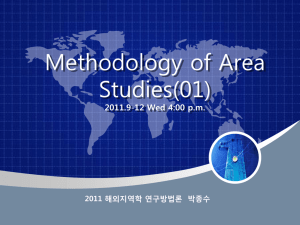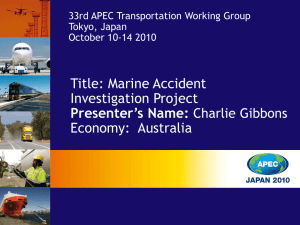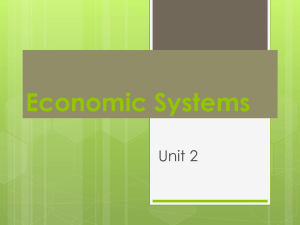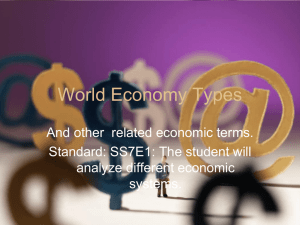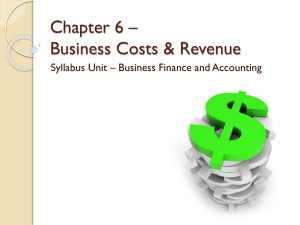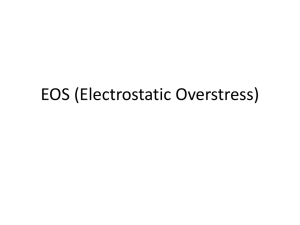Powerpoint Presentation
advertisement
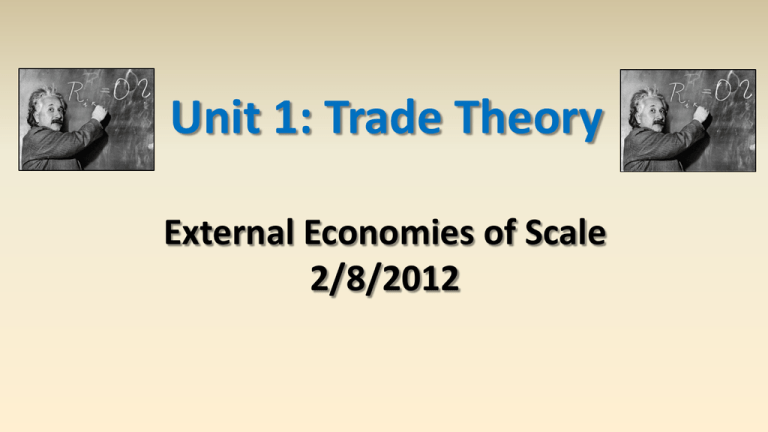
Unit 1: Trade Theory External Economies of Scale 2/8/2012 Definitions constant returns to scale – increases in output are proportional to increases in inputs F(aK,aL) = aF(K,L) Definitions increasing returns to scale (economies of scale) – increases in output are more than proportional to increases in inputs F(aK,aL) > aF(K,L) Definitions external economies of scale – cost per unit of output depends on the size of the industry internal economies of scale – cost per unit of output depends on the size of a firm Definitions specialized suppliers – a single firm would not be a large enough market to support specialized equipment or support services, but an entire industry concentrated in one location is large enough Definitions labor pooling – a large and concentrated industry may attract a pool of workers, reducing employee search and hiring costs for each firm Definitions knowledge spillovers – workers from different firms may more easily share ideas that benefit each firm when a large and concentrated industry exists Definitions Fig. 7-1: External Economies and Market Equilibrium forward-falling (downward sloping) supply curve – average cost of production falls as industry output rises Definitions dynamic increasing returns to scale (dynamic economies of scale) – average costs fall as cumulative output over time rises compare with: increasing returns to scale (economies of scale) – average costs fall as current output rises Definitions infant industry argument – temporary protection of industries allows them to gain experience and thus economies of scale Definitions economic geography – the study of international trade, interregional trade and the organization of economic activity in metropolitan and rural areas Returns to Scale Previous models (Ricardian, specific factors, Heckscher-Ohlin, & standard trade) assumed constant returns to scale. The next two models assume increasing returns to scale (economies of scale). Definitions increasing returns to scale (economies of scale) – increases in output are more than proportional to increases in inputs F(aK,aL) > aF(K,L) Returns to Scale The above example shows increasing returns to scale (doubling inputs more than doubles output). Notice also that average amount of labor to produce each unit of output falls as output rises (more efficient). Returns to Scale Mutually beneficial trade can arise as a result of economies of scale. International trade permits each country to produce a limited range of goods (taking advantage of economies of scale to produce more efficiently) without sacrificing variety in consumption. Definitions external economies of scale – cost per unit of output depends on the size of the industry internal economies of scale – cost per unit of output depends on the size of a firm Returns to Scale External & internal economies of scale are important causes of international trade. External EoS will typically consist of many perfectly competitive small firms. Internal EoS will typically consist of imperfectly competitive large firms. This lecture (ch. 7) deals with external; the next lecture (ch. 8) deals with internal. External EoS: Theory External EoS examples • Silicon Valley, CA, USA o semiconductors • Hollywood, CA, USA o entertainment • New York City, NY, USA o investment banking • Qiaotou, China o buttons External EoS: Theory Reasons for External EoS • specialized suppliers • labor market pooling • knowledge spillovers Definitions specialized suppliers – a single firm would not be a large enough market to support specialized equipment or support services, but an entire industry concentrated in one location is large enough Definitions labor pooling – a large and concentrated industry may attract a pool of workers, reducing employee search and hiring costs for each firm Definitions knowledge spillovers – workers from different firms may more easily share ideas that benefit each firm when a large and concentrated industry exists Definitions Fig. 7-1: External Economies and Market Equilibrium forward-falling (downward sloping) supply curve – average cost of production falls as industry output rises External EoS: Theory Fig. 7-1: External Economies and Market Equilibrium External economies of scale can be represented by assuming the larger the industry, the lower the industry’s cost. This means average cost (AC) is declining. Because the supply curve is AC, the supply curve is forward-falling (downward sloping). External EoS: International Trade Fig. 7-2: External Economies Before Trade Before international trade equilibrium prices and output for each country are at the intersection of domestic supply and domestic demand. Here China has a lower price for butons. External EoS: International Trade Fig. 7-3: Trade and Prices After trade the Chinese button industry will expand and the U.S. button industry will contract (China’s button prices are lower). As China’s button industry expands, its costs fall & its button prices fall; As U.S.’s button industry contracts, its costs rise & its button prices rise. China gets all button production. External EoS: International Trade Fig. 7-3: Trade and Prices Before trade Chinese button prices were lower than U.S. button prices. Because China’s supply curve is slopes down, increased production leads to an even lower price. Trade leads to prices that are lower than either country’s autarky prices! External EoS: International Trade Fig. 7-3: Trade and Prices In the standard trade model relative prices converge: the effect of trade is to raise prices in the relatively cheap country and reduce them in the relatively expensive country. With external economies of scale trade reduces prices everywhere! External EoS: International Trade What causes initial price advantages? • comparative advantage o differences in technology & resources • historical accidents o start as large producers External EoS: International Trade Historical Accidents A tufted blanket wedding gift by a 19th-century teenager gave rise to the cluster of carpet manufacturers around Dalton, Georgia. Silicon Valley may owe its existence to two Stanford graduates named Hewlett and Packard who started a business in a garage there. External EoS: International Trade Fig. 7-4: The Importance of Established Advantage There is no guarantee that the right country will produce a good that is subject to external economies. Consider this example: Vietnam’s AC curve is below China’s AC curve (perhaps due to lower wages in Vietnam). External EoS: International Trade Fig. 7-4: The Importance of Established Advantage At any given level of production, Vietnam could manufacture buttons more cheaply than China. Does this mean Vietnam will supply the world market? Not necessarily if China has enough of a head start! External EoS: International Trade Fig. 7-4: The Importance of Established Advantage China produces at point 1. If Vietnam won the industry, it could produce at point 2. But when Vietnam starts it will produce at C0 (at a price above P1), so Vietnam can’t takeover the world market. External EoS: International Trade Fig. 7-5: External Economies and Losses from Trade There will be gains to the world economy by concentrating production of industries with external economies But with external economies of scale it is theoretically possible for a country to be better of in autarky than with trade. External EoS: International Trade Fig. 7-5: External Economies and Losses from Trade Here Thailand could make watches more cheaply, but Switzerland got there first. The price of watches could be lower in Thailand with no trade. In practice it is very hard to ex ante identify industries that would have a lower cost than the world’s if trade were blocked. External EoS: International Trade Fig. 7-5: External Economies and Losses from Trade Even though autarky can increase a country’s welfare, it’s still to the benefit of the world to take advantage of the gains from concentrating industries. Each industry with external economies should be concentrated somewhere. Definitions dynamic increasing returns to scale (dynamic economies of scale) – average costs fall as cumulative output over time rises increasing returns to scale (economies of scale) – average costs fall as current output rises Dynamic Increasing Returns Fig. 7-6: The Learning Curve Dynamic increasing returns to scale can arise if production cost depends on the accumulation of knowledge and experience. The learning curve is a graphical representation of dynamic increasing returns to scale. Definitions infant industry argument – temporary protection of industries allows them to gain experience and thus economies of scale Dynamic Increasing Returns Fig. 7-6: The Learning Curve Like external economies of scale, dynamic increasing returns to scale can lock in an initial advantage in an industry. This can be used to justify protectionism through the infant industry argument. Dynamic Increasing Returns Fig. 7-6: The Learning Curve The infant industry argument leads to over-protectionism. “Temporary” protection often persists for many, many years. It is hard to identify ex ante when (dynamic) external economies of scale really exist. Economic Geography External economies may be important for interregional trade within a country. For example: entertainment in Hollywood, financial firms in New York City, etc. Economic Geography Some nontradable goods like newspapers and haircuts must be supplied locally. If external economies exist, the pattern of trade may be due to historical accidents Definitions economic geography – the study of international trade, interregional trade and the organization of economic activity in metropolitan and rural areas



